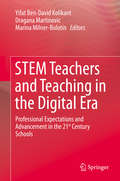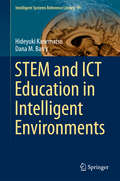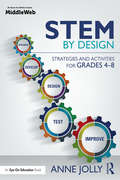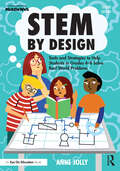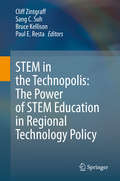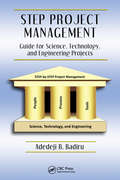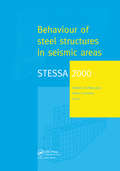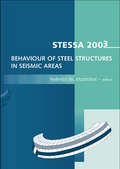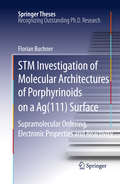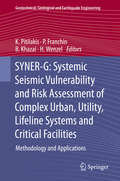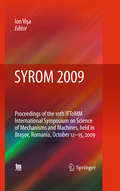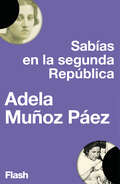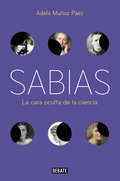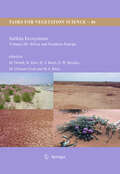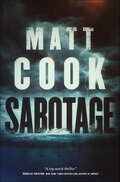- Table View
- List View
STEM Teachers and Teaching in the Digital Era: Professional Expectations and Advancement in the 21st Century Schools
by Dragana Martinovic Yifat Ben-David Kolikant Marina Milner-BolotinThis book brings together researchers from Israel and Canada to discuss the challenges today's teachers and teacher‐educators face in their practice.There is a growing expectation that the 21st century STEM teachers re‐examine their teaching philosophies and adjust their practices to reflect the increasing role of digital technologies. This expectation presents a significant challenge to teachers, who are often asked to implement novel technology‐rich pedagogies they did not have a chance to experience as students or become comfortable with. To exacerbate this challenge, the 21st century teachers function not only in a frequently‐changing educational reality manifested by continuous reforms, but are also bombarded by often contradictory and competing demands from the legislators, administrators, parents, and students. How do we break the vicious circle of reforms and support STEM teachers in making a real change in student learning? This book is unique for at least three reasons. First, it showcases research situated in Israel and Canada that examines the challenges today's teachers and teacher‐educators face in their practice. While the governments of both countries emphasize STEM education, their approaches are different and thus provide for interesting comparisons. Second, in addition to including research-based chapters, prominent scholars discuss the contributions in each of the book sections, problematizing the issues from a global perspective. Third, technology has a potential to empower teachers in this era of change, and this book provides the unique insights from each country, while allowing for comparisons, discussing solutions, and asking new questions.This book will be of interest to all involved in STEM teacher education programs or graduate programs in education, as well as to educational administrators interested in implementing technology in their schools.
STEM and ICT Education in Intelligent Environments
by Hideyuki Kanematsu Dana M. BarryThis book combines information communication technology (ICT) with the creative interdisciplinary teaching approach known as STEM (science, technology, engineering and mathematics). It introduces STEM and Creative Education and shows (through examples and creative activities) the importance and impact that ICT has for STEM and modern education. The book describes the audio visual classroom, the use of the Internet, Social Networking and STEM and provides STEM lessons for both the real and virtual worlds. Instructors will find this unique textbook to be very useful with students, of various ages, in creative education and engineering classes. This special book offers something for everyone. It serves as a guide for teachers in charge of science fairs and creative classes, especially those which require STEM education. It also includes activities to help develop creative thinking and problem-solving skills and prepares students who plan to become teachers and mentors of the future. Readers in general can simultaneously enjoy and learn about ICT's impact on STEM and modern education. In addition, e-learning designers and administrators who want to introduce e-learning systems into their organizations can refer to this book as a reference and a resource. The book complements most e-learning and ICT education books which generally focus too much on technical issues.
STEM by Design: Strategies and Activities for Grades 4-8
by Anne JollyHow do you create effective STEM classrooms that energize students, help them grow into creative thinkers and collaborators, and prepare them for their futures? This practical book from expert Anne Jolly has all the answers and tools you need to get started or enhance your current program. Based on the author’s popular MiddleWeb blog of the same name, STEM by Design reveals the secrets to successful lessons in which students use science, math, and technology to solve real-world engineering design problems. You’ll learn how to: Select and adapt quality existing STEM lessons that present authentic problems, allow for creative approaches, and engage students in meaningful teamwork; Create your own student-centered STEM lessons based on the Engineering Design Process; Assess students’ understanding of basic STEM concepts, their problem-solving abilities, and their level of engagement with the material; Teach STEM in after-school programs to further build on concepts covered in class; Empower girls to aspire to careers in STEM and break down the barriers of gender bias; Tap into STEM's project-based learning style to attract and engage all students. Throughout this user-friendly book, you’ll find design tools such as checklists, activities, and assessments to aid you in developing or adapting STEM lessons. These tools, as well as additional teacher resources, are also available as free downloads from the book’s website, http://www.stem-by-design.com.
STEM by Design: Tools and Strategies to Help Students in Grades 4–8 Solve Real-World Problems
by Anne JollyThe second edition of this practical, how-to guide from expert STEM teacher Anne Jolly reveals the secrets behind designing projects that involve students in using science, math, and technology to engineer solutions for real-world problems. Fully revised and updated from the first edition, each chapter is packed with tools and strategies to help you design and lead exciting STEM projects and lessons and help your students grow into creative thinkers, innovators, and collaborators prepared for life in the 21st century. You’ll learn how to: Select engaging and relevant STEM challenges. Design your own STEM projects using the engineering design process and other acknowledged STEM criteria. Convert existing lessons into quality STEM projects. Include students of different ethnicities and other underrepresented children. Build students’ abilities to work successfully in teams and practice important life skills. Integrate technology into your projects in authentic ways. Assess students’ understanding of STEM concepts and procedures, problem-solving progress, and level of engagement in the project. Involve students in assessing and adjusting their own progress throughout the project. Throughout this user-friendly book you’ll find design tools such as checklists, activities, and assessments to aid you in designing and adapting energizing STEM lessons with your students in Grades 4–8. These tools, as well as other teacher resources, are also available as free downloads from the book website, www.stem-by-design.com.
STEM for All: How to Connect, Create, and Cultivate STEM Education for All Learners
by Leena Bakshi McLeanHelp close the STEM gap through theory and practical tools Containing all of the practical tools needed to put theory into practice, STEM for All by Leena Bakshi McLean provides a roadmap for teachers, instructional coaches, and leaders to better understand the challenges that create low engagement and scores in STEM subjects and implement exciting and culturally relevant teaching plans. This book covers a wealth of key topics surrounding the subject, including classroom culture, discourse, identity, and belonging, family and community participation, and justice-centered core learning. This book uses the Connect, Create, and Cultivate framework from STEM4Real, an organization that provides socially just and culturally relevant STEM teaching and standards-based learning strategies, combined with stories and case studies of real students throughout to provide context for key concepts. In this book, readers will learn about: Six pillars that can throw off the foundation of a classroom, including non-inclusive curriculum and lack of equal access Moments of triumph and resilience that can be used to navigate rocky and recalcitrant relationships Implicit and unconscious biases that can unravel our impact despite our best intentions STEM for All earns a well-deserved spot on the bookshelves of all educators motivated to close the STEM gap and better prepare their students for future college and career opportunities in math and science fields.
STEM in the Technopolis: The Power of STEM Education in Regional Technology Policy
by Sang C. Suh Cliff Zintgraff Bruce Kellison Paul E. RestaThis book addresses how forward-thinking local communities are integrating pre-college STEM education, STEM pedagogy, industry clusters, college programs, and local, state and national policies to improve educational experiences, drive local development, gain competitive advantage for the communities, and lead students to rewarding careers. This book consists of three sections: foundational principles, city/regional case studies from across the globe, and state and national context. The authors explore the hypothesis that when pre-college STEM education is integrated with city and regional development, regions can drive a virtuous cycle of education, economic development, and quality of life.Why should pre-college STEM education be included in regional technology policy? When local leaders talk about regional policy, they usually talk about how government, universities and industry should work together. This relationship is important, but what about the hundreds of millions of pre-college students, taught by tens of millions of teachers, supported by hundreds of thousands of volunteers, who deliver STEM education around the world? Leaders in the communities featured in STEM in the Technopolis have recognized the need to prepare students at an early age, and the power of real-world connections in the process. The authors advocate for this approach to be expanded. They describe how STEM pedagogy, priority industry clusters, cross-sector collaboration, and the local incarnations of global development challenges can be made to work together for the good of all citizens in local communities. This book will be of interest to government policymakers, school administrators, industry executives, and non-profit executives. The book will be useful as a reference to teachers, professors, industry professional volunteers, non-profit staff, and program leaders who are developing, running, or teaching in STEM programs or working to improve quality of life in their communities.
STEM-Infusing the Elementary Classroom
by Miranda Talley ReaganMake learning relevant with STEM essential questions This engaging, teacher-friendly guide helps teachers quickly and confidently infuse STEM concepts into all content areas. Real-world vignettes, sample lesson templates, discussion questions and immediately applicable action steps help you seamlessly promote college and career ready skills. Use this inspiring guide to: Deepen all content areas, including English/ Language Arts Promote the 4Cs: communication, collaboration, critical thinking, and creativity Require students to take risks to solve problems Differentiate instruction and scaffold support Expand students’ specific measurable capabilities Incorporate design skills into the curricula Save valuable time and confidently develop standards-aligned STEM projects in all content areas!
STEM-Infusing the Elementary Classroom
by Miranda Talley ReaganMake learning relevant with STEM essential questions This engaging, teacher-friendly guide helps teachers quickly and confidently infuse STEM concepts into all content areas. Real-world vignettes, sample lesson templates, discussion questions and immediately applicable action steps help you seamlessly promote college and career ready skills. Use this inspiring guide to: Deepen all content areas, including English/ Language Arts Promote the 4Cs: communication, collaboration, critical thinking, and creativity Require students to take risks to solve problems Differentiate instruction and scaffold support Expand students’ specific measurable capabilities Incorporate design skills into the curricula Save valuable time and confidently develop standards-aligned STEM projects in all content areas!
STEP Project Management: Guide for Science, Technology, and Engineering Projects (Systems Innovation Book Series)
by Adedeji B. BadiruWhile the project management body of knowledge is embraced by disciplines ranging from manufacturing and business to social services and healthcare, the application of efficient project management is of particularly high value in science, technology, and engineering undertakings. STEP Project Management: Guide for Science, Technology, and Engineeri
STESSA 2000: Proceedings of the Third International Conference STESSA 2000, Montreal, Canada, 21-24 August 2000
by Federico M. Mazzolani; Robert TremblayThis is a review of developments in the behaviour and design of steel structures in seismic areas. The proceedings look at the analytical and experimental research on the seismic response of steel structures, and cover topics such as global behaviour and codification, design and application.
STESSA 2003 - Behaviour of Steel Structures in Seismic Areas: Proceedings of the 4th International Specialty Conference, Naples, Italy, 9-12 June 2003
by Federico M. MazzolaniPresenting a comprehensive overview of recent developments in the field of seismic resistant steel structures, this volume reports upon the latest progress in theoretical and experimental research into the area, and groups findings in the following key sections:· performance-based design of structures· structural integrity under exceptional loading· material and member behaviour· connections· global behaviour· moment resisting frames· passive and active control· strengthening and repairing· codification· design and application
STM Investigation of Molecular Architectures of Porphyrinoids on a Ag(111) Surface
by Florian BuchnerThe self-assembly of large organic molecules has become a vividly explored and interdisciplinary field in science. One major goal is the tailored fabrication of highly ordered, molecular networks, which are stabilized on a metal surface. Metalloporphyrins receive particular attention, because their distinct intrinsic functionalities make them promising candidates for applications in chemical sensors, solar cells, and for tailored catalytic processes. Based on scanning tunneling microscopy investigations, several novel and fundamental contributions are presented, which has led to a new level of understanding. Highlights are the results with respect to intramolecular conformation and supramolecular ordering, electronic interactions with the substrate, surface confined synthesis such as in-situ metallation reactions, and ligand effects.The number of publications this work has led to emphasises its quality and significance.
SUMMARY OF A WORKSHOP ON INFORMATION TECHNOLOGY RESEARCH for Federal Statistics
by National Research Council Committee on National Statistics Compature Science Telecommunications BoardSUMMARY OF A WORKSHOP ON INFORMATION TECHNOLOGY RESEARCH for Federal Statistics
SWORDS INTO MARKET SHARES: Technology, Economics, and Security in the New Russia
by Glenn E. SchweitzerWhile researching this book, Glenn Schweitzer met four Moscow physicists who were trying to license Russian technology to western firms for product manufacture. During the worst times, they were reduced to driving taxis to keep things afloat. He asked them, will technological innovation have a discernible impact on the Russian economy in the coming decade? No, was the immediate reply. Are they right?In Swords into Market Shares, Schweitzer examines the roots of such pessimism and the prospects for Russia to prosper from its technology in the post-Soviet world. He explores the different visions of prosperity held by entrepreneurs, technologists, and government officials and goes on to examine the barriers to progress as Russia struggles to build a viable technology industry on its own terms. In accessible language, this book talks about technology's place within Russia's economy and its research and development infrastructure. Schweitzer looks at the impact of the Soviet legacy--central planning, lack of priorities, scant incentives for personal initiative--and the aftermath of the Russian financial meltdown of 1998.He also reviews the experiences of American companies that have invested in Russian technology and examines the results of pressure to reform according to the economic model of the West. Schweitzer goes on to document the problems of economic crime and government corruption, which plague activities designed to generate income in Russia. He discusses the lack of protection for intellectual property and taxation issues that stand in the way of technological innovation. The book looks at the impact of the "brain drain" as Russian experts seek greener pastures--not only the ominous recruitment of Russian biological weapons experts and the acquisition of military technology by "rogue" nations--but also Russia's own program to sell military technology for badly needed funds.Schweitzer's use of case studies and examples puts a human face on these issues. He also discusses Russia's 60 "science cities"--sites of state research centers--with close-ups of three "nuclear cities."Can the technical strengths of the Soviet military complex find a place in civilian Russia? How can this vast country sustain even a minimal standard of living? Swords into Market Shares addresses these and other key questions and explores fundamental policy issues confronting both Russia and the United States as Russia struggles for an economic foothold.
SYNER-G: Systemic Seismic Vulnerability and Risk Assessment of Complex Urban, Utility, Lifeline Systems and Critical Facilities
by K. Pitilakis P. Franchin B. Khazai H. WenzelSYNER-G, a multidisciplinary effort funded by the European Union, allowed the development of an innovative methodological framework for the assessment of physical as well as socio-economic seismic vulnerability and risk at urban and regional level. The results of SYNER-G are presented in two books both published by Springer, the present and a second one, entitled "SYNER-G: Typology Definition and Fragility Functions for Physical Elements at Seismic Risk: Buildings, Lifelines, Transportation Networks and Critical Facilities"(*), which provides a comprehensive state-of-the-art of the fragility curves, an alternative way to express physical vulnerability of elements at risk. In this second volume of SYNER-G, the focus has been on presenting a unified holistic methodology for assessing vulnerability at systems level considering interactions between elements at risk (physical and non-physical) and between different systems. The proposed methodology and tool encompasses in an integrated fashion all aspects in the chain, from hazard to the vulnerability assessment of components and systems and to the socio-economic impacts of an earthquake, accounting for most relevant uncertainties within an efficient quantitative simulation scheme. It systematically integrates the most advanced fragility functions to assess the vulnerability of physical assets for buildings, utility systems, transportation networks and complex infrastructures such as harbours and hospitals. The increasing impact due to interactions between different components and systems is treated in a comprehensive way, providing specifications for each network and infrastructure. The proposed socio-economic model integrates social vulnerability into the physical systems modelling approaches providing to decision makers with a dynamic platform to capture post disaster emergency issues like shelter demand and health impact decisions Application examples at city and regional scale have provided the necessary validation of the methodology and are also included in the book. The present volume, with its companion volume on fragility functions, represent a significant step forward in the seismic vulnerability and risk assessment of complex interacting urban and regional systems and infrastructures. These volumes are not only of interest to scientists and engineers but also to the insurance industry, decision makers and practitioners in the sector of civil protection and seismic risk management. (*) Pitilakis K, Crowley E, Kaynia A (eds) (2014) SYNER-G: Typology definition and fragility functions for physical elements at seismic risk, Series: Geotechnical, Geological and Earthquake Engineering 27, ISBN 978-94-007-7872-6, Springer Science+Business Media, Dordrecht.
SYROM 2009
by Ion VisaSYROM conferences have been organized since 1973 by the Romanian branch of the International Federation for the Promotion of Mechanisms and Machine Science IFToMM, Year by year the event grew in quality. Now in its 10th edition, international visibility and recognition among the researchers active in the mechanisms science field has been achieved. SYROM 2009 brought together researchers and academic staff from the field of mechanisms and machine science from all over the world and served as a forum for presenting the achievements and most recent results in research and education. Topics treated include conceptual design, kinematics and dynamics, modeling and simulation, synthesis and optimization, command and control, current trends in education in this field, applications in high-tech products. The papers presented at this conference were subjected to a peer-review process to ensure the quality of the paper, the engineering significance, the soundness of results and the originality of the paper. The accepted papers fulfill these criteria and make the proceedings unique among the publications of this type.
Sabias en la Segunda República (Flash Ensayo)
by Adela Muñoz PáezUn breve recorrido por la historia de la ciencia española y sus primeras grandes científicas. ¿Qué papel desempeñaron las mujeres durante la Edad de Plata que la ciencia vivió en la Segunda República española? Adela Muñoz Páez rescata la historia de algunas de las mujeres españolas que han hecho contribuciones relevantes a la ciencia y paralelamente, para entender por qué fueron tan escasas y hoy son tan desconocidas, realiza un paseo por la España de comienzos del siglo XX hasta nuestros días. Así, descubriremos que el movimiento feminista español gestado a finales del siglo XIX dio sus frutos más brillantes durante la Segunda República; que debido a la guerra una generación entera de científicas cayó en el olvido y que durante el franquismo no solo se anularon todos los logros conseguidos en cuestiones de igualdad, sino que se desprestigió a las mujeres y los hombres que los protagonizaron y se borraron sus huellas de los anales de la ciencia. Hoy su redescubrimiento es un ejercicio de justicia histórica para que por fin brillen con todo su esplendor.
Sabias: La otra cara de la ciencia
by Adela Muñoz PáezUn fascinante recorrido por la historia de las mujeres de la ciencia. ¿Quién fue Enheduanna? ¿Y Émilie de Châtelet? ¿Por qué los maestros cerveceros consideran su mentora a Hildegarda de Bingen, una monja del siglo XI? ¿Fue Marie Curie merecedora de los dos premios Nobel de ciencias que recibió? ¿Habría sido posible descifrar la estructura del ADN sin el trabajo de Rosalind Franklin? ¿Por qué es tan desconocida la mujer que desentrañó la estructura de la penicilina? ¿Qué papel tuvieron las mujeres durante la Edad de Plata que la ciencia vivió en la Segunda República española? En este libro rescatamos la historia de algunas de las mujeres que han hecho contribuciones relevantes en la ciencia y paralelamente, para entender porqué fueron tan escasas y hoy son tan desconocidas, realizamos un recorrido por la historia. En este paseo descubrimos que hasta bien entrado el siglo XX, las mujerestuvieron vetado el ingreso en las universidades y el ejercicio de muchas profesiones que requerían estudios, y que antes habían sido expulsadas de las bibliotecas de los monasterios, los centros donde se refugió el saber durante la Edad Media. También descubrimos que sus historias fueron borradas de los anales de la ciencia o sus contribuciones les fueron arrebatadas. Las mujeres científicas de la historia están siendo hoy redescubiertas para pasmo y solaz de propios y extraños, y brillan con todo su esplendor.
Sabkha Ecosystems
by Münir Öztürk Benno Böer Hans-Jörg Barth Siegmar-W. Breckle M. Ajmal Khan Miguel Clüsener-GodtThis book is part of the Sabkha Ecosystems series. The series is designed to provide information on sabkha ecosystems of different regions. It will add to the collective knowledge available about saline ecosystems and also focuses on the African region where only limited information is currently available on.
Sabkha Ecosystems: Volume VI: Asia/Pacific (Tasks for Vegetation Science #49)
by Benno Böer M. Ajmal Khan Miguel Clüsener-Godt Bilquees Gul Abdul HameedThis book is the sixth and final volume in the Tasks for Vegetation Science book series, and it concludes the most comprehensive scientific documentation dealing with hypersaline ecosystems of the world.
Sabotage
by Matt CookA cruise ship loses power in the North Atlantic. A satellite launches in the South Pacific. Professor Malcolm Clare—celebrated aviator, entrepreneur, and aerospace engineer—disappears from Stanford University and wakes up aboard an unknown jet, minutes before the aircraft plunges into the high seas. An extortionist code-named "Viking" has seized control of a private warfare technology, pitting a U.S. defense corporation against terrorist conspirators in a bidding war. His leverage: a threat to destroy the luxury liner and its 3,000 passengers. Stanford doctoral student Austin Hardy, probing the disappearance of his professor, seeks out Malcolm Clare's daughter Victoria, an icy brunette with a secret that sweeps them to Saint Petersburg. Helped by a team of graduates on campus, they must devise Trojan horses, outfox an assassin, escape murder in Bruges, and sidestep treachery in order to unravel Viking's scheme. Failure would ensure economic armageddon in the United States.Both on U.S. soil and thousands of miles away, the story roars into action at supersonic speed. Filled with an enigmatic cast of characters, Sabotage, Matt Cook's debut novel, is a sure thrill ride for those who love the puzzles of technology, cryptology, and people. At the Publisher's request, this title is being sold without Digital Rights Management Software (DRM) applied.
Sabr and Sabr LIBOR Market Models in Practice: With Examples Implemented in Python (Applied Quantitative Finance)
by Peter Larkin Christian Crispoldi GéraldwiggerSabr and Sabr LIBOR Market Models in Practice.
Sachem Head's Activism at Autodesk
by Suraj Srinivasan Quinn PitcherIn 2015, activist hedge fund Sachem Head Capital, led by founder Scott Ferguson, launched an activist campaign at (computer aided design) CAD software maker Autodesk. The activist campaign, waged mainly in private, was over Autodesk's lacklustre financial performance, with Ferguson thinking that Autodesk's performance could improve with better cost management. Facing a proxy contest, Autodesk added Ferguson and two others to its board in exchange for a standstill agreement. Following two years of significantly improved performance, Ferguson eventually stepped down when longtime Autodesk CEO Carl Bass announced his retirement in February 2017. The case illustrates how even companies with stellar products can underperform and how benchmarking and financial analysis can help identify drivers of firm performance. The case describes how boards and investors can engage to improve governance and ultimately achieve sustainable performance objectives.
Sacramento’s Moon Rockets (Images of Modern America)
by Don Brincka Alan Lawrie Rebecca AllenOn July 16, 1969, a Saturn V rocket launched the Apollo spacecraft carrying American astronauts to the surface of the moon, where Neil Armstrong would take his famous first steps and fulfill Pres. John F. Kennedy's goal of a successful lunar landing by the end of the decade. This event marks one of the greatest achievements in human history and is in large part due to the years of rocket testing that took place at the Douglas Aircraft Company's Sacramento testing facility (SACTO). The SACTO facility played one of the most important roles in the success of the Apollo 11 lunar mission and is where the Saturn rocket's S-IVB stage was developed and tested--making this historic accomplishment possible.
Sad Topographies
by Damien RuddSad Topographies is an illustrated guide for the melancholic among us. Dispirited travellers rejoice as Damien Rudd journeys across continents in search of the world’s most joyless place names and their fascinating etymologies. Behind each lugubrious place name exists a story, a richly interwoven narrative of mythology, history, landscape, misadventure and tragedy. From Disappointment Island in the Southern Ocean to Misery in Germany, across to Lonely Island in Russia, or, if you’re feeling more intrepid, pay a visit to Mount Hopeless in Australia – all from the comfort of your armchair. With hand drawn maps by illustrator Kateryna Didyk, Sad Topographies will steer you along paths that lead to strange and obscure places, navigating the terrains of historical fact and imaginative fiction. At turns poetic and dark-humoured, this is a travel guide quite like no other. Damien Rudd is the founder of the hugely popular Instagram account @sadtopographies.
